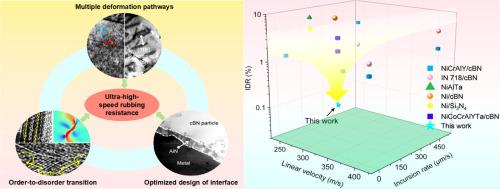通过精确的结构和成分设计,在NiAlTa/cBN复合材料中实现卓越的超高速摩擦阻力
IF 14.3
1区 材料科学
Q1 MATERIALS SCIENCE, MULTIDISCIPLINARY
引用次数: 0
摘要
摩擦磨损造成的能源和材料损失约占全球能源消耗的23%,因此减少和控制磨损是一项不懈的追求。实现极端工况(超高速、超高温、超高应变率)下的耐磨性是材料设计的追求。本文通过精密的材料组成和结构设计,开发了用于高温涡轮叶片尖端的NiAlTa/cBN复合材料,实现了抗磨损和抗冲击。该复合材料具有迄今为止报道的最低侵入深度比。这种优异的超高速摩擦性能源于其固有结构的高热软化性能和多种变形途径(超位错、FCC→HCP相变、断层和变形孪晶)引起的协同硬化。金属/陶瓷界面的优化设计和异质结构的摩擦诱导摩擦层也有助于优异的超高速摩擦抗力。在高应变速率下,界面处原子有序向无序转变可以有效地协调塑性变形和耗散冲击应变能。本文章由计算机程序翻译,如有差异,请以英文原文为准。

Achieving exceptional ultra-high-speed rubbing resistance in NiAlTa/cBN composites through precise structural and compositional design
Friction and wear cause about 23% of global energy consumption in terms of energy and material loss, so reducing and controlling wear is a relentless pursuit. Realizing wear resistance under extreme operating conditions (ultra-high speeds, ultra-high temperatures, and ultra-high strain rates) is the pursuit of material design. Here, a NiAlTa/cBN composite is developed for high-temperature turbine blade tips to achieve wear and impact resistance through precise material component and structure design. The composite exhibits the lowest incursion depth ratio reported to date. This excellent ultra-high-speed rubbing resistance stems from the high thermal-softening resistance of its intrinsic structure and the synergistic hardening induced by multiple deformation pathways (superdislocations, FCC→HCP phase transitions, faults, and deformation twins). The optimized design of the metal/ceramic interface and the tribo-induced tribo-layers with heterostructures also contribute to the excellent ultra-high-speed rubbing resistance. At high strain rates, the atomic order-to-disorder transition at the interface can effectively coordinate plastic deformation and dissipate impact strain energy.
求助全文
通过发布文献求助,成功后即可免费获取论文全文。
去求助
来源期刊

Journal of Materials Science & Technology
工程技术-材料科学:综合
CiteScore
20.00
自引率
11.00%
发文量
995
审稿时长
13 days
期刊介绍:
Journal of Materials Science & Technology strives to promote global collaboration in the field of materials science and technology. It primarily publishes original research papers, invited review articles, letters, research notes, and summaries of scientific achievements. The journal covers a wide range of materials science and technology topics, including metallic materials, inorganic nonmetallic materials, and composite materials.
 求助内容:
求助内容: 应助结果提醒方式:
应助结果提醒方式:


